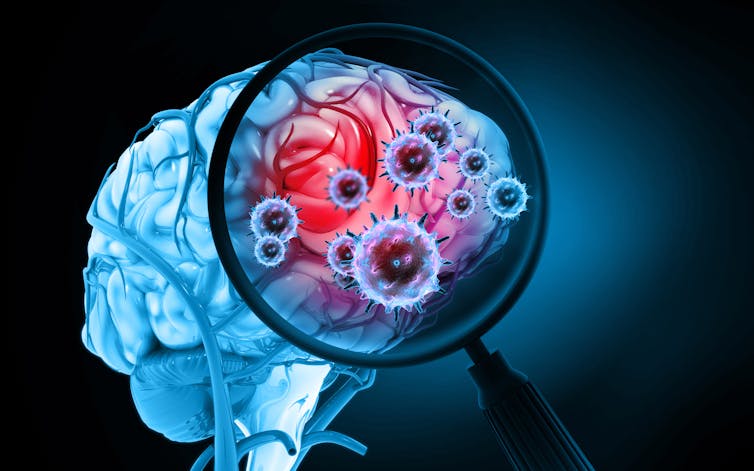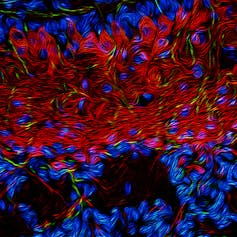
Andrew Bubak, University of Colorado Anschutz Medical Campus; Diego Restrepo, University of Colorado Anschutz Medical Campus, and Maria Nagel, University of Colorado Anschutz Medical Campus
One in nine Americans ages 65 and over had Alzheimer’s disease in 2022, and countless others were indirectly affected as caregivers, health care providers and taxpayers. There is currently no cure – available treatments primarily focus on prevention by encouraging protective factors, such as exercise and healthy diet, and reducing aggravating factors, such as diabetes and high blood pressure.
One of these aggravating factors is viral infections. Researchers have identified that certain viruses such as herpes simplex virus type 1 (HSV-1, which causes cold sores), varicella zoster virus (VZV, which causes chickenpox and shingles) and SARS-CoV-2 (which causes COVID-19) can lead to a higher risk of Alzheimer’s disease and dementia following infection.
Figuring out how and when these viruses contribute to disease could help scientists develop new therapies to prevent dementia. However, researchers have been unable to consistently detect suspect viruses in brains of people who died of Alzheimer’s. Because the Alzheimer’s disease process can start decades before symptoms, some researchers have proposed that viruses act early in a “hit-and-run” manner; they trigger a cascade of events that lead to dementia but have already taken off. In other words, by the time researchers analyze patient brains, any detectable viral components are gone and causation is difficult to establish.
We are a neurovirologist, neurologist and neuroscientist team interested in the role viruses play in neurodegenerative diseases. In our recently published research, we use new technology to search for the tire tracks of these viruses in Alzheimer’s patients. By focusing on the most vulnerable entry point to the brain, the nose, we discovered a genetic network that provides evidence of a robust viral response.
Focusing on the olfactory system
Many of the viruses implicated in dementia, including herpesviruses and the virus that causes COVID-19, enter the nose and interact with the olfactory system.
The olfactory system is constantly bombarded with odors, pollutants and pathogens. Particles inhaled through the nostrils bind to specific olfactory receptor cells in the tissue lining the nasal cavity. These receptors send messages to other cells in what’s called the olfactory bulb, which acts like a relay station that transmits these messages down the long nerves of the olfactory tract. These messages are then transferred to the area of the brain responsible for learning and memory, the hippocampus.
The hippocampus plays a critical role assigning contextual information to odors, such as danger from the foul smell of propane or comfort from the smell of lavender. This area of the brain is also dramatically damaged in Alzheimer’s disease, causing devastating learning and memory deficits. For as many as 85% to 90% of Alzheimer’s patients, loss of smell is an early sign of disease.
The mechanism leading to smell loss in Alzheimer’s disease is relatively unknown. Like muscles that atrophy from lack of use, sensory deprivation is thought to lead to atrophy of the brain regions that specialize in interpreting sensory information. Strong sensory input to these regions is critical to maintain general brain health.
Olfactory inflammation and Alzheimer’s disease
We hypothesize that viral infections throughout life are both contributors to and potential drug targets in Alzheimers’s disease. To test this idea, we used emerging, state-of-the-art technology to investigate the mRNA and protein networks of the olfactory system of Alzheimer’s disease patients.
The body uses mRNA, which is transcribed from DNA, to translate genetic material into proteins. The body uses specific mRNA sequences to produce a network of proteins that are used to fight against certain viruses. In some cases, the body continues to activate these pathways even after the the virus is cleared, leading to chronic inflammation and tissue damage. Identifying which mRNA sequences and protein networks are present can allow us to infer, to a degree, whether the body is or was responding to a viral pathogen at some point.
Previously, sequencing mRNA in tissue samples was difficult because the molecules degrade very quickly. However, new technology specifically addresses that issue by measuring small subsections of mRNA at a time instead of trying to reconstruct the whole mRNA sequence at once.
We leveraged this technology to sequence the mRNA of olfactory bulb and olfactory tract samples from six people with familial Alzheimer’s, an inherited form of the disease, and six people without Alzheimer’s. We focused on familial Alzheimer’s because there is less variability in disease than in the sporadic, or nonfamilial, form of the disease, which can result from a number of different individual and environmental factors.

In the familial Alzheimer’s samples, we found altered gene expression indicating signs of a past viral infection in the olfactory bulb, as well as inflammatory immune responses in the olfactory tract. We also found higher levels of proteins involved in demyelination in the olfactory tract of familial Alzheimer’s samples than in the controls. Myelin is a protective fatty layer around nerves that allows electrical impulses to move quickly and smoothly from one area of the brain to another. Damage to myelin stalls signal transduction, resulting in impaired neural communication and, by extension, neurodegeneration.
Based on these findings, we hypothesize that viral infections, and the resulting inflammation and demyelination within the olfactory system, may disrupt the function of the hippocampus by impairing communication from the olfactory bulb. This scenario could contribute to the accelerated neurodegeneration seen in Alzheimer’s disease.
Implications for patient health
Epidemiological data supports the role of viral infections in the development of Alzheimer’s disease. For example, the varicella zoster virus is linked to a nearly threefold risk of developing dementia within five years of infection for patients with a shingles rash on their face. A recent report also found a nearly 70% increased risk of getting diagnosed with Alzheimer’s within a year of a COVID-19 diagnosis for people over 65.
These studies suggest that vaccination may be a potential measure to prevent dementia. For example, vaccination against the seasonal flu virus and herpes zoster is associated with an up to 29% and 30% reduced risk of developing dementia, respectively.
Further research investigating how viral infections can trigger neurodegeneration could aid in the development of antiviral drugs and vaccines against the viruses implicated in Alzheimer’s disease.![]()
Andrew Bubak, Assistant Research Professor of Neurology, University of Colorado Anschutz Medical Campus; Diego Restrepo, Professor of Cell and Developmental Biology, University of Colorado Anschutz Medical Campus, and Maria Nagel, Professor of Neurology and Ophthalmology, University of Colorado Anschutz Medical Campus
This article is republished from The Conversation under a Creative Commons license. Read the original article.